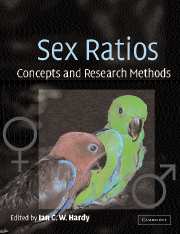Book contents
- Frontmatter
- Contents
- List of contributors
- Preface and acknowledgements
- Part 1 Sex ratio theory
- Chapter 1 Models of sex ratio evolution
- Chapter 2 Optimal sex allocation: steps towards a mechanistic theory
- Part 2 Statistical analysis of sex ratio data
- Part 3 Genetics of sex ratio and sex determination
- Part 4 Animal sex ratios under different life-histories
- Part 5 Sex ratios in plants and protozoa
- Part 6 Applications of sex ratios
- Index
- References
Chapter 1 - Models of sex ratio evolution
Published online by Cambridge University Press: 06 August 2009
- Frontmatter
- Contents
- List of contributors
- Preface and acknowledgements
- Part 1 Sex ratio theory
- Chapter 1 Models of sex ratio evolution
- Chapter 2 Optimal sex allocation: steps towards a mechanistic theory
- Part 2 Statistical analysis of sex ratio data
- Part 3 Genetics of sex ratio and sex determination
- Part 4 Animal sex ratios under different life-histories
- Part 5 Sex ratios in plants and protozoa
- Part 6 Applications of sex ratios
- Index
- References
Summary
Summary
Our understanding of sex ratio evolution depends strongly on models that identify: (1) constraints on the production of male and female offspring, and (2) fitness consequences entailed by the production of different attainable brood sex ratios. Verbal and mathematical arguments by, among others, Darwin, Düsing, Fisher, and Shaw and Mohler established the fundamental principle that members of the minority sex tend to have higher fitness than members of the majority sex. They also outlined how various ecological, demographic and genetic variables might affect the details of sex-allocation strategies by modifying both the constraints and the fitness functions. Modern sex-allocation research is devoted largely to the exploration of such effects, which connect sex ratios to many other aspects of the biologies of many species. The models used in this work are of two general kinds: (1) expected-future-fitness or tracer-gene models that ask how a given sex allocation will affect the future frequencies of neutral genes carried by the allocating parent, and (2) explicit population-genetic models that consider the dynamics of alleles that determine alternative parental sex allocation phenotypes. Each kind of model has different strengths and weaknesses, and both are often essential to the full elucidation of a given problem.
Introduction
Males and females are produced in approximately equal numbers in most species with separate sexes, regardless of the mechanism of sex determination, and in most hermaphroditic species individuals expend approximately equal effort on male and female reproductive functions. Why should this be so?
- Type
- Chapter
- Information
- Sex RatiosConcepts and Research Methods, pp. 2 - 25Publisher: Cambridge University PressPrint publication year: 2002
References
- 40
- Cited by



